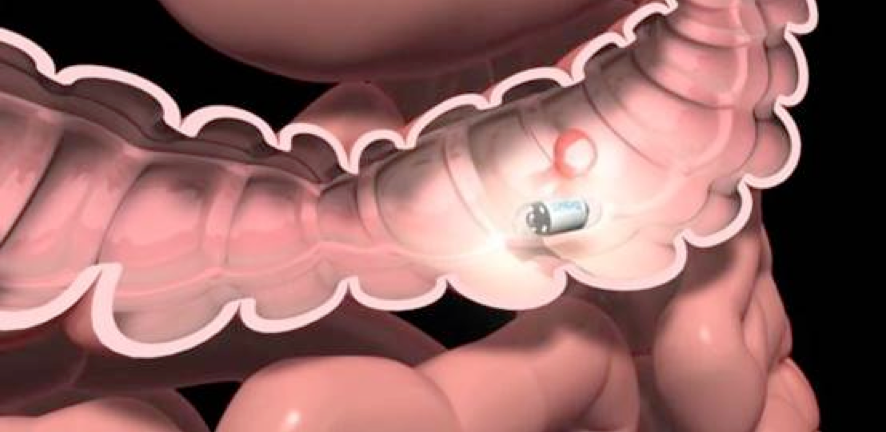Capsule Endoscopy
Capsule endoscopy
Capsule endoscopy is a procedure used to record internal images of the gastrointestinal tract for use in medical diagnosis. Newer developments are also able to take biopsies and release medication at specific locations of the entire gastrointestinal tract . The capsule (aka pill cam) is similar in shape to a standard pharmaceutical capsule, although a little larger, and contains a tiny camera and an array of LEDs powered by a battery. After a patient swallows the capsule, it passes along the gastrointestinal tract taking a number of images per second which are transmitted wirelessly to an array of receivers connected to a portable recording device carried by the patient.

Capsule endoscopy
Capsule endoscopy is a procedure used to record internal images of the gastrointestinal tract for use in medical diagnosis. Newer developments are also able to take biopsies and release medication at specific locations of the entire gastrointestinal tract . The capsule (aka pill cam) is similar in shape to a standard pharmaceutical capsule, although a little larger, and contains a tiny camera and an array of LEDs powered by a battery. After a patient swallows the capsule, it passes along the gastrointestinal tract taking a number of images per second which are transmitted wirelessly to an array of receivers connected to a portable recording device carried by the patient.

Capsule endoscopy
Capsule endoscopy is a procedure used to record internal images of the gastrointestinal tract for use in medical diagnosis. Newer developments are also able to take biopsies and release medication at specific locations of the entire gastrointestinal tract . The capsule (aka pill cam) is similar in shape to a standard pharmaceutical capsule, although a little larger, and contains a tiny camera and an array of LEDs powered by a battery. After a patient swallows the capsule, it passes along the gastrointestinal tract taking a number of images per second which are transmitted wirelessly to an array of receivers connected to a portable recording device carried by the patient.

Capsule Endoscopy
Capsule endoscopy is a non-invasive medical procedure that involves swallowing a small, pill-sized capsule equipped with a camera and light source. This capsule, often referred to as a “camera pill,” travels through the digestive tract, capturing images of the gastrointestinal (GI) tract’s inner lining as it moves along. These images are wirelessly transmitted to a recording device worn by the patient, allowing healthcare providers to visualize and analyze the condition of the GI tract.

Here's how capsule endoscopy works:
- Ingestion: The patient swallows the capsule, which is about the size of a large vitamin pill. The capsule is designed to pass naturally through the digestive system.
- Image Capture: As the capsule travels through the GI tract, it captures thousands of images using the built-in camera and light source. The images provide a detailed view of the mucosal lining of the esophagus, stomach, small intestine, and sometimes parts of the colon, depending on the specific type of capsule used.
- Data Transmission: The images are transmitted wirelessly from the capsule to a small recording device worn by the patient. This device is typically worn around the waist or carried in a pouch.
- Data Analysis: After the procedure, the recording device is returned to the healthcare provider. The captured images are then downloaded and reviewed by a medical professional, such as a gastroenterologist. The images provide valuable insights into the health of the GI tract, helping to diagnose various conditions.
Capsule endoscopy is commonly used for several purposes:
- Small Intestine Examination: It is especially useful for visualizing the small intestine, as this part of the GI tract is not easily reached by traditional endoscopy or colonoscopy.
- Diagnosis: Capsule endoscopy can help diagnose conditions such as obscure gastrointestinal bleeding (bleeding of unknown origin), Crohn’s disease, celiac disease, tumors, polyps, and other abnormalities in the GI tract.
- Monitoring: It can be used to monitor the progression of certain conditions over time, track the effectiveness of treatments, or assess the healing of the GI tract after treatment.
Capsule endoscopy is generally well-tolerated and less invasive than traditional endoscopic procedures. The capsule is usually excreted naturally within a day or two after ingestion. However, there are some limitations to capsule endoscopy, such as its inability to perform biopsies or treat conditions during the procedure.
Patients may be asked to follow specific preparation instructions before the procedure, such as fasting and avoiding certain medications, to ensure clear and accurate images. As with any medical procedure, there are potential risks and complications, although they are relatively rare. Your healthcare provider will guide you on whether capsule endoscopy is suitable for your condition and provide instructions for the procedure.

